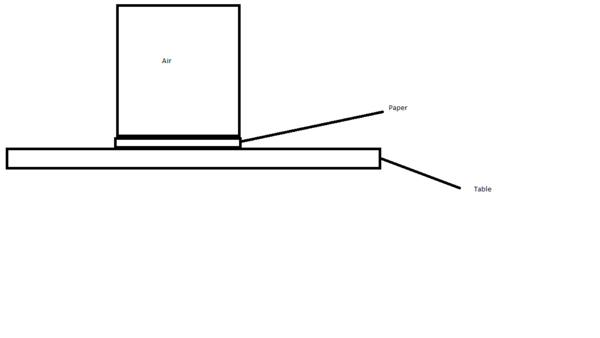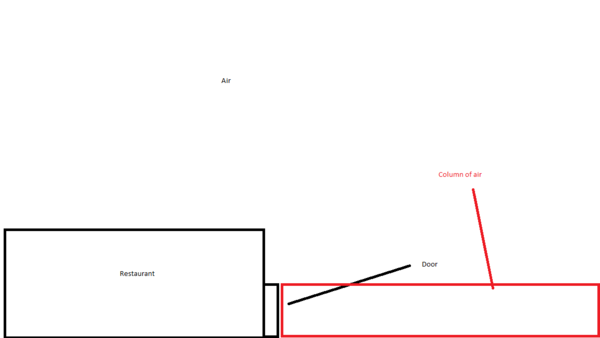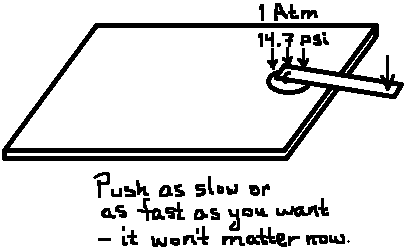Air pressure inside restaurants
-
What's the deal with air pressure inside restaurants?
It seems like half the time I go out to eat somewhere, it's difficult to open the door when I leave (but not when I enter, for some reason!) because there's a minor vacuum seal holding the door closed. As soon as I push it open a little ways, there's a big whoosh of air flowing in from outside, and then suddenly it's not hard to open at all.
Does anyone have any idea what causes this, and why it's so common in restaurants specifically? I don't experience it at homes or other places of business.
-
@masonwheeler said in Air pressure inside restaurants:
What's the deal with air pressure inside restaurants?

-
@masonwheeler The huge fans in the kitchen pushing all the air outside, without anything getting fresh air inside.
-
What do we look like, stack overflow

-
If your phone is one of these
you can install an app to measure the atmospheric pressure and get numeric evidence!
-
-
It's a marketing ploy.
Low air pressure increases appetite, because the negative pressure outside your body makes your stomach feel more empty. This is why you are so insatiably hungry on airplanes you're willing to eat the shit food they give you, and why NASA fears astronauts may resort to killing (and eating) eachother on long space voyages.
-
-
@The_Quiet_One 7/10. Needs more illuminati
-
@masonwheeler you get award for the most obscure random complaint on TDWTF... this week.
-
Is air strong enough to break the ruler? We're gonna find out!
GEE I WONDER WHAT'S GOING TO HAPPEN NEXT IN THIS VIDEO TITLED "AIR PRESSURE BREAKS A RULER".
-
@anonymous234 It the same principle why the door is harder to open when leaving the restaurant.
-
@lucas1 I thought that was because it's 10 beers and three rums later.
-
@lucas1 ...uh yeah, that completely ignores the fact that the newspaper also has a lot of inertia, plus air resistance (which is not exactly the same thing as air pressure).
I bet if he suspended the newspaper over an open frame (just enough support to keep the newspaper from falling through) so it has air pressure on both sides, it'd still break the ruler if he tried that trick with it.
If you want a better demonstration of air pressure, just look at a suction cup. Air pressure is what it holds it in place once it's stuck.
-
@anotherusername no it wouldn't
You don't understand how pressure works in a fluid (fluid can mean things like air depending on certain things which I have probably forgot).
In the example in the video he has say a regular newspaper. It is 600 x 750 mm according to google as standard. It has a ~ 0.5 m area (I rounded up for simplicity).

Say you have a 2 meter high ceiling, you would need to move 2 x 0.5 volume of air with sufficient force. It has to move that whole column of air out of the way to "let the ruler (that is under the sheet)" move upwards. If that overcomes the sheering force in the wooden ruler , then it breaks. That is assuming it doesn't include the displacement of all the air around that column in the shitty paint diagram I made.
Now think about the restaurant example. Imagine this is a door that is usually 2m x 1meter wide. Going into the restautant it only has to move a small amount of air. When going back outside you literally have to move the local atmosphere a little to get out.

-
@lucas1 said in Air pressure inside restaurants:
Going into the restautant it only has to move a small amount of air. When going back outside you literally have to move the local atmosphere a little to get out.
That doesn't make any sense. When going in or out, you have to do exactly the same thing: open the door. How does it involve moving less air one way?
-
@masonwheeler Look at the diagram provided and think.
BTW they they aren't supposed to be at scale. I just made them in Paint to illustrate.
-
@lucas1 said in Air pressure inside restaurants:
Say you have a 2 meter high ceiling

Um, no. That is irrelevant. It makes zero difference how high the ceiling is; you have atmospheric pressure inside the room.
It has to move that whole column of air out of the way to "let the ruler (that is under the sheet)" move upwards.
No, it doesn't. Now you don't understand how a fluid works. Air resistance is not the pressure of lifting a column of air; it's the pressure of moving something through it -- some, but not all, of the air in the column has to move out of the way. You're not lifting all of the air; most of it just gets pushed aside and flows around the sides of whatever you're moving. And there will be just as much air resistance if you're moving it down, or sideways, (oriented so its cross section size relative to the direction of motion is the same, obviously) as there is if you're lifting it up like he was.
Now think about the restaurant example. Imagine this is a door that is usually 2m x 1meter wide. Going into the restautant it only has to move a small amount of air. When going back outside you literally have to move the local atmosphere a little to get out.
That's completely not what's happening, at all.
If that were the case, it would be hard to open the door (outward) in all buildings, not just ones where the air pressure inside was lowered by giant fans pushing air out without adequate ventilation allowing air to come back in.
I'll see your MS Paint physics diagram and raise you one. Here's my suction cup example:

...now you're not pushing against inertia, or air resistance (well, there's still a little bit of inertia, and air resistance, but now they're negligible). You're pushing almost entirely against the air pressure that's holding the suction cup down.
-
@lucas1 said in Air pressure inside restaurants:
You don't understand how pressure works in a fluid
Actually, you don't. If it was a perfect incompressible fluid, that might be true. But air is not an incompressible fluid, let alone a perfect one.
-
@tufty ...let alone have the structural integrity that would be required to move an entire column of it upward, frozen solid like a chunk of ice, rather than having most of it just mush around the sides of whatever you're moving through it.
TBH I'm not sure if this is /b/-style
 science, and the joke's on us, or if he really believes that.
science, and the joke's on us, or if he really believes that.
-
if he really believes that
Hey, look. We both got downvoted, my guess is that he does.
-
@tufty Yes I do. Yes an in-compressible fluid acts differently but for this trite example it is good enough approximation for the explanation that is need here.
Approximations are fine for the moment.
The same effect happens in my flats for much the same reasons. If all the windows in the corridor are closed then it takes quite a bit of my body weight to shift the door, it the windows are open it opens easily.
-
@anotherusername It isn't like you are trying to move a massive solid object.
-
@lucas1 said in Air pressure inside restaurants:
It isn't like you are trying to move a massive solid object.
And yet, apparently, it is.
-
@tufty Nope. The video I showed above shows the basic principle, it doesn't take much the extrapolate the same idea to a door and a smaller room. Air us compressible you are correct, but if you try moving it there is still a force element involved, you are trying to accelerate a mass of something in a particular direction ... F = ma applies.
You can observe the same the other way, If you leave your windows open and let the door slam it will slam hard, if you have do the same when all your windows are closed it probably won't.
M going into the restaurant is significantly lower than when going out, so it makes sense that the door is more difficult to open when exiting.
If you have any solid counter arguments where I have made incorrect assumptions I would be quite interested.
-
@lucas1 It doesn't show the process for that exact use case. Therefore, you are an idiot. :tufty:
-
@lucas1 I already explained why you're wrong. Go back up and read my posts again. Your explanation was completely off point.
Trying to move a sheet of paper, with about a square meter of surface area, against air will generate a pretty significant amount of air resistance. This is regardless of which direction you're moving it (or how much open space there is between it and the nearest solid surface in the direction -- ceiling, wall, mountain).
And that air resistance will dwarf whatever amount of air pressure he's actually demonstrating in his video. As I said, drape the newspaper over a hollow frame with a couple of structural cross elements to hold it up in the middle. If you can still break the ruler, then my analysis is correct. Because by hitting the ruler hard and fast like he does, you're maximizing the affects of both inertia and air resistance -- to the point where I'm pretty sure the role played by air pressure is actually pretty much inconsequential.
The suction cup example, though, will actually demonstrate the power of air pressure -- not air resistance, and not inertia -- because a tiny little suction cup can easily break a wooden ruler.
there is still a force element involved, you are trying to accelerate a mass of air in a particular direction ... F = ma applies.
Yes... and most of it is moving perpendicular to your direction of motion, so it can flow around the moving object. A very small wave of pressure is generated, but mostly it dissipates, unless you use some type of tube to funnel and direct it, like the Airzooka toy thing:

-
This post is deleted!
-
@anotherusername said in Air pressure inside restaurants:
And that air resistance will dwarf whatever amount of air pressure he's actually demonstrating in his video. As I said, drape the newspaper over a hollow frame with a couple of structural cross elements to hold it up in the middle. If you can still break the ruler, then my analysis is correct. Because by hitting the ruler hard and fast like he does, you're maximizing the affects of both inertia and air resistance -- to the point where I'm pretty sure the role played by air pressure is actually pretty much inconsequential
He explains why he is hitting it hard, so that the air pressure difference is highest between the top of the paper and the bottom. You will notice he does a jump cut in the video to get something that is obviously lays flat.
-
The air pressure inside is not a 2m column, it's a 1 atmosphere column, or very close to it. If there's a significant difference between the air pressure inside and the atmospheric pressure outside, you'd have difficulty opening the door -- and I don't mean push with an extra 5 or 10 pounds of force, against a door that has an area of about 16 ft2 (1.5 m2); that's only about a 4% difference, ~0.6 PSI, between atmospheric pressure outside and air pressure inside. Atmospheric pressure is a lot more than just the pressure of a 2 meter column of air; if you truly had the air pressure of a 2 meter column of air inside, you could put 10 people pushing against the door as hard as you could and you probably still wouldn't be able to open it.
@lucas1 said in Air pressure inside restaurants:
He explains why he is hitting it hard, so that the air pressure difference is negligible to the example.
 Do you even know what "negligible" means? If you're trying to demonstrate the power of something, you want it to be the opposite of negligible, or it's not a good demonstration.
Do you even know what "negligible" means? If you're trying to demonstrate the power of something, you want it to be the opposite of negligible, or it's not a good demonstration.
-
 Do you even know what "negligible" means? If you're trying to demonstrate the power of something, you want it to be the opposite of negligible, or it's not a good demonstration.
Do you even know what "negligible" means? If you're trying to demonstrate the power of something, you want it to be the opposite of negligible, or it's not a good demonstration.He wants almost no atmosphere underneath it so it can't fuck up the demo. Jesus.
-
@anotherusername said in Air pressure inside restaurants:
The air pressure inside is not a 2m column, it's a 1 atmosphere column, or very close to it. If there's a significant difference between the air pressure inside and the atmospheric pressure outside, you'd have difficulty opening the door -- and I don't mean push with an extra 5 or 10 pounds of force, against a door that has an area of about 16 ft2 (1.5 m2); that's only about a 4% difference, ~0.6 PSI, between atmospheric pressure outside and air pressure inside. Atmospheric pressure is a lot more than just the pressure of a 2 meter column of air; if you truly had the air pressure of a 2 meter column of air inside, you could put 10 people pushing against the door as hard as you could and you probably still wouldn't be able to open it.
There isn't a significant different between the air pressure outside and inside. There is a significant difference between the amount of air you have to move, when entering and exiting the building.
-
@lucas1 and what I'm saying is if there was one atmosphere of pressure below the paper and above it, the ruler would still break. Because I think the air pressure is pretty much a non-factor in his experiment.
So like I said, use an open frame so there's air pressure on both sides of the paper, and try the experiment again. If you can't still break the ruler, I'd have to admit that air pressure is probably playing a significant role in it. But if you can still break the ruler, it's not.
-
@anotherusername Why I have seen the same experiment then when the same weight of paper was folded up and place on top of the ruler and the ruler threw the paper off ...
-
@lucas1 because the air resistance of the paper is proportional to its cross section. The air resistance of an unfolded sheet of paper is a lot more than the air resistance of it when it's folded into a smaller rectangle.
You could feel the amount of air resistance by taking a big sheet of cardboard and trying to wave it through the air. Then fold it in half, or in quarters, and it'll be significantly easier -- there will be less air resistance.
-
@anotherusername That is the idea, it is going to be even higher when there isn't much air under the paper. Because there isn't going to load of air pressure one side and none the other side.
-
Air isn't the only thing that's dense.
-
@lucas1 then why not just use the suction cup, so you can get almost all the air out from under it, as I suggested?
Since the suction cup is small, the air resistance will be small. But the air pressure will be tremendous.
-
@CodEmperor It isn't dense.
-
Wow, does this need to be moved to the
 garage?
garage?
-
@anotherusername because it isn't over a wide area.
-
@masonwheeler Apparently people don't believe what happends in front of their eyes.
-
@lucas1 the fact that it's air pressure pushing against a small area and generating that much force just serves to prove the point even better.
But look, I've already suggested 3 different experiments that would prove what I'm saying. So if you want to argue the point further, I suggest you try them.
- same experiment, using the ruler to lift the paper, but outdoors instead of indoors (almost no difference at all)
- same experiment, using the ruler to lift the paper, but with an open frame under the paper instead of a solid table, so it has air pressure on both sides (very little difference)
- same experiment, but trying to pull up a suction cup that's stuck to the table instead of lifting a paper (way, way harder: now you're really feeling the power of the air pressure, where before you really weren't)
-
@lucas1 oh, I believe what happened alright. I just disagree with his explanation of why it happened.
-
How about you do this experiement.
- Just leave the windows open in your house and let the door go, It will slam hard,.
- Shut the windows in your house and let the door go, it won't slam.
-
@lucas1
 now I'm sure that you're just messing with me. That is not what will happen, unless maybe there's a hurricane-force wind blowing directly into your open windows.
now I'm sure that you're just messing with me. That is not what will happen, unless maybe there's a hurricane-force wind blowing directly into your open windows.But by all means, you go ahead and try it.
-
@anotherusername said in Air pressure inside restaurants:
No, it doesn't. Now you don't understand how a fluid works. Air resistance is not the pressure of lifting a column of air; it's the pressure of moving something through it -- some, but not all, of the air in the column has to move out of the way. You're not lifting all of the air; most of it just gets pushed aside and flows around the sides of whatever you're moving. And there will be just as much air resistance if you're moving it down, or sideways, (oriented so its cross section size relative to the direction of motion is the same, obviously) as there is if you're lifting it up like he was.
Pushing that stuff aside requires movement, which implies velocity with requires force. It doesn't matter where the air goes, it matter that it has to move.
-
@lucas1 that is called air resistance, not air pressure.
-
@lucas1 said in Air pressure inside restaurants:
Now think about the restaurant example. Imagine this is a door that is usually 2m x 1meter wide. Going into the restautant it only has to move a small amount of air. When going back outside you literally have to move the local atmosphere a little to get out.
Except that the door opens in the same direction whether you are going in or out. The primary difference tends to be that traffic going in tends to be around the same time, so pressure within the restaurant doesn't have a chance to differ much from pressure outside. On the other hand, different groups take different amounts of time to eat, so exiting groups are staggered more. As a result, there is often more of a difference between when people are leaving then when they are arriving, so the air pressure difference caused by the kitchen ventilation is more significant as some patrons are leaving.
-
@anotherusername It is a combination of both.
There is a weight of air, and there is a resistance. I simplified my explanation to one as that was more noticeable.
If it was water, oil or something else I would have said differently.
